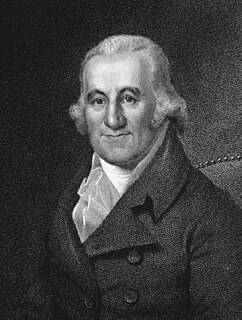
John Mayo (1761–1818) was an English physician.

John Mayo (1761–1818) was an English physician.
The son of Thomas Mayo, and grandson of Charles Mayo of Hereford, he was born in Hereford 10 December 1761. He matriculated at Oxford in 1778 at Brasenose College, and graduated B.A. 1782. He was elected Fellow of Oriel College 16 April 1784, and proceeded M.A. 1785, M.B. 1787, and M.D. 1788. [1]
Mayo became Fellow of the Royal College of Physicians of London 30 September 1789, and was censor in 1790, 1795, 1804, and 1808. He was Harveian orator in 1795. He served as physician to the Foundling Hospital from July 1787 to 1809, to the Middlesex Hospital 6 November 1788 until 11 January 1803, and was also physician in ordinary to the Princess of Wales. From 1802 the Middlesex Hospital made him physician extraordinary to their cancer ward. [1]
Coming to divide his time between London and Tunbridge Wells, Mayo resided at the latter during the summer months, where he was the leading physician. On resigning his hospital appointments in 1817, he settled at Tunbridge Wells, and dying 29 November 1818, was buried at Speldhurst, Kent. [1]
Mayo published The Information and Complaint made to the Court at the Hospital for the Maintenance and Education of exposed and deserted Children, 1790. [2] His eldest son Thomas published Remarks on Insanity, founded on the Practice of John Mayo, M.D., 1817. [3] Mayo had been physician to Ticehurst House Hospital, and Thomas continued in the post. [4]
Mayo married twice. With his first wife, Jane, daughter of Thomas Cock, esq., of Tottenham, he had three sons: Thomas, a physician; John, in holy orders; and Herbert. His second wife was Frances Lavinia, daughter of William Fellowes of Ramsey Abbey, Member of Parliament for Ludlow and Andover. [5]
![]() This article incorporates text from a publication now in the public domain : Lee, Sidney, ed. (1894). "Mayo, John". Dictionary of National Biography . 37. London: Smith, Elder & Co.
This article incorporates text from a publication now in the public domain : Lee, Sidney, ed. (1894). "Mayo, John". Dictionary of National Biography . 37. London: Smith, Elder & Co.

Caspar Wistar was an American physician and anatomist. He is sometimes referred to as Caspar Wistar the Younger, to distinguish him from his grandfather of the same name.

Sir Lucius Henry O'Brien, 3rd Baronet PC (Ire) was an Irish baronet and politician for 34 years.

George Man Burrows was an English physician who was an expert on insanity.
Thomas Mayo was a British physician.

John Yelloly was an English physician.

Latham of Bradwall is a family whose seat was at Bradwall Hall, in the township of Bradwall, near Sandbach, England, with several notable members. The line is "a junior branch of the ancient Cheshire house of Lathom, of Lathom and Knowsley, which terminated in the heiress, Isabella Latham, who married Sir John Stanley, Knt., ancestor of the Earls of Derby".

Henry Revell Reynolds was an English physician.

John Latham, FRS, M.D. was an English physician. He became President of the Royal College of Physicians, and also updated their Pharmacopoeia.

John Haslam (1764–1844) was an English apothecary, physician and medical writer, known for his work on mental illness. Haslam's case study of James Tilly Matthews is the earliest detailed description of paranoid schizophrenia.

Sir Christopher Pegge M.D. (1765–1822) was an English physician.

Thomas Norris was an English musician, known as a singer and composer.
Rogers Ruding (1751–1820) was an English cleric and academic, known as a numismatist and the author of the Annals of the Coinage. He was the Vicar of Malden, Surrey from 1793 until his death in 1820. Prior to his marriage in May 1793, he was the Reverend Clerk at St George's, Bloomsbury, in London.
William Thomson (1746–1817) was a Scottish minister, historian and miscellaneous writer. He often wrote under the pseudonym of Captain Thomas Newte and this fictitious character had his own history and received independent recognition.
William Ridgeway (1765–1817) was an Irish barrister and law reporter.
Sir James Stonhouse, 11th Baronet (1716–1795) was an English physician and cleric, known as a hospital founder and religious writer.

Dr John Hunter FRSE (1754–1809) was a Scottish physician linked to Jamaica.

Henry William Coulthurst (1753–1817) was an English cleric and academic.
Benjamin Thomas Pouncy was an English draughtsman and engraver.